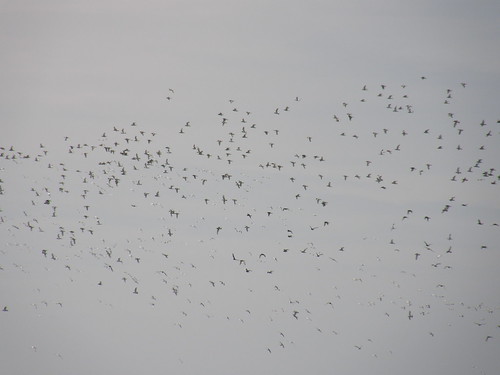
Our days in North Wales sound found a regular rhythm – late to rise, leisurely breakfast, a few hours on the beach, back for lunch, return to the beach late afternoon, late tea, late to bed. This seemed to work quite well and the kids slept in OK, but once the sun gets on the canvas I inevitably wake and want to be up and about. So I added my own quiet prelude to each day – a solitary stroll along the coastal path and the lanes. We had bikes with us and sometimes I used my bike to extend the range of my short excursions.
The first of these walks began with blue sky overhead and mist all around. Mist bedecked webs glittered all along the fence. I assumed that the mist would soon burn off, but instead it would clear only to roll in again, the view appearing and disappearing with the whims of the mist.

One of the delights of these walks was the abundance of bird life, mainly sea-birds and ‘lbj’s. I’m not very confident with identifying either. Is this, for example, a juvenile greenfinch as the sturdy beak suggests (but where’s the greeny-yellow wing bar?) or a female house sparrow? (but if so why is such a gregarious bird all alone?).
There’s certain wildlife I’ve come to associate with our trips to the Llyn Peninsula. One is the choughs which we saw on the grassy ‘cliffs’ when we were on the beach. Another is the labyrinth spider Agelena labyrinthica. We’d seen webs, but not spiders, on the gorse bushes on the lower slopes of Carn Fadryn, now I found many more webs on the gorse bushes on the cliff-top.

I have an idea that this rather round bodied spider is the female and a more skinny body…

…might belong to a male. But I don’t know why I think that.
The mist flagged up the extent to which the gorse was blanketed with gossamer…

…with orb webs as well as the labyrinth type…

Incidentally, the mini-Fuji in the background is Carn Fadryn.
At the end of the peninsula Yr Eifl and its neighbours stood out above the mist…

…but was soon curtained off again.

Meadow Brown

Another lbj…

…a sedge warbler?
My friend J, (the Adopted Yorkshirewoman) a gardener, had asked me about the abundant purple flowers in the hedgerows, or actually more often in the ditches. “Purple-loosestrife” I confidently told her.

But I wanted to be sure that I was telling her right, so I took photos of leaves and stem for identification purposes and discovered that the stem is square sectioned and hairy with a red rib on each corner…

..which pleased me at least.
I’ve subsequently discovered that…
Close examination of the flowers shows that although those of any one plant are the same, they may differ from plant to plant. Different plants may have any one of three sorts of flower, which vary in the position of their male and female parts (stamens and stigmas). The stigma may project beyond the sepal tube, it may be level with the tips of the sepals, or it may be hidden inside. Each of the two whorls of stamens also vary in position. A bee feeding on nectar of one sort of flower will receive a dusting of pollen on two parts of its tongue from the two whorls of stamens. This pollen will be in the right positions to be brushed onto the stigmas of the two other sorts of flower when the bee visits them. This arrangement makes sure that the flowers of one plant are fertilised only by pollen from another of the same species, ensuring the vigour of the species.
..which is also rather wonderful.
This bird….

…led me a merry dance, hopping about at the back of one of the local broad humped ‘hedges’.

A whitethroat?

..and his mate?

Dry dock!

Another lbj. This one surely is a sparrow, which must make the first a greenfinch?
Another plant the AYW asked about was this small blue flower, sometimes forming quite dense clumps and providing lots of colours in the hedges. I couldn’t put name to it at the time, but after some fairly torturous research I’m now confident that it’s sheep’s-bit.

It’s common in the South of England and Wales apparently which is perhaps why, resident in the red and white rose counties, the AYW and I are not familiar with it.

Another gatekeeper.

Red admiral.

Bindweed.


I think that this little corker might be a cinquefoil, but I far from confident, and if it is I don’t know which.
I thought that I might dispense with all of my early morning strolls from Towyn Farm in one post but clearly I had forgotten just how absorbing that first walk was.
















































































































